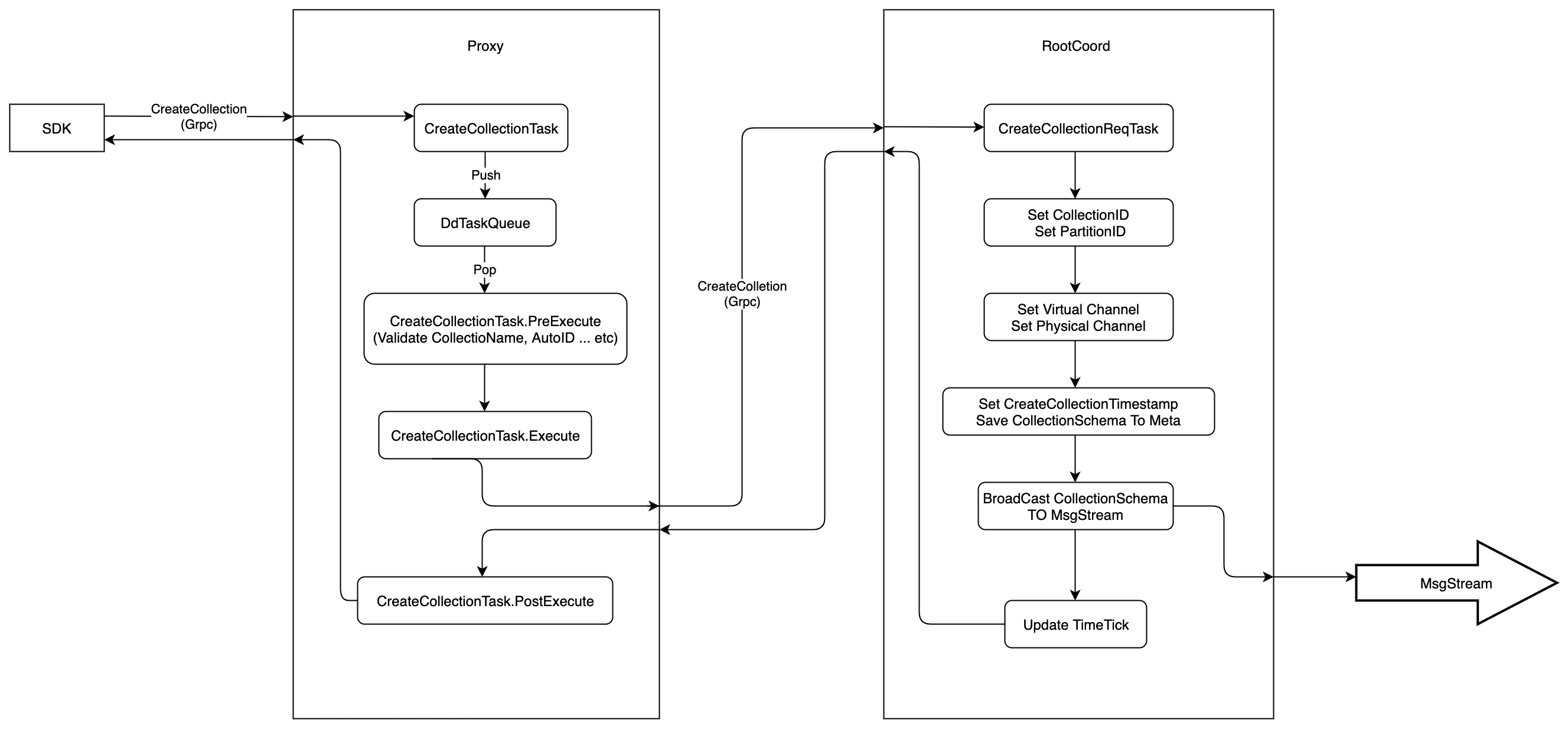5.5 KiB
metaSnapShot
metaSnapShot enables RootCoord to query historical meta based on timestamp, it provides Key-Vaule interface. Take an example to illustrate what metaSnapShot is. The following figure shows a series of operations happened on the timeline.
| Timestamp | Operation |
|---|---|
| 100 | Set A=1 |
| 200 | Set B=2 |
| 300 | Set C=3 |
| 400 | Set A=10 |
| 500 | Delete B |
| 600 | Delete C |
Now assuming the Wall-Clock is Timestamp=700, so B should have been deleted from the system. But I want to know the value of B at Timesamp=450, how to do it? metaSnapShot is invented to solve this problem.
We need to briefly introduce etcd's MVCC before metaSnapShot. Here is the test program:
package etcdkv
import (
"context"
"testing"
"time"
"github.com/stretchr/testify/assert"
"go.etcd.io/etcd/clientv3"
)
func TestMVCC(t *testing.T) {
addr := []string{"127.0.0.1:2379"}
cli, err := clientv3.New(clientv3.Config{Endpoints: addr})
assert.Nil(t, err)
assert.NotNil(t, cli)
ctx, cancel := context.WithTimeout(context.Background(), 10*time.Second)
defer cancel()
testKey := "test-key"
rsp0, err := cli.Delete(ctx, testKey)
assert.Nil(t, err)
t.Logf("revision:%d", rsp0.Header.Revision)
rsp1, err := cli.Put(ctx, testKey, "value1")
assert.Nil(t, err)
t.Logf("revision:%d,value1", rsp1.Header.Revision)
rsp2, err := cli.Put(ctx, testKey, "value2")
assert.Nil(t, err)
t.Logf("revision:%d,value2", rsp2.Header.Revision)
rsp3, err := cli.Get(ctx, testKey, clientv3.WithRev(rsp1.Header.Revision))
assert.Nil(t, err)
t.Logf("get at revision:%d, value=%s", rsp1.Header.Revision, string(rsp3.Kvs[0].Value))
}
The output of above test program should look like this:
=== RUN TestMVCC
etcd_mvcc_test.go:23: revision:401
etcd_mvcc_test.go:27: revision:402,value1
etcd_mvcc_test.go:31: revision:403,value2
etcd_mvcc_test.go:35: get at revision:402, value=value1
--- PASS: TestMVCC (0.01s)
In etcd, each writes operation would add 1 to Revision. So if we specify the Revision value at query, we can get the historical value under that Revision.
metaSnapShot is based on this feature of etcd. We will write an extra Timestamp on each write operation. etcd's Txn makes sure that the Timestamp would have the same Revision with user data.
When querying, metaSnapShot will find an appropriate Revision based on the input Timestamp, and then query on etcd with this Revision.
In order to speed up getting Revision by Timestamp, metaSnapShot would maintain an array mapping the Timestamp to Revision. The default length of this array is 1024, which is a type of circular array.
maxPospoints to the position whereTimestampandRevisionare maximum.minPospoints to the position whereTimestampandRevisionare minimum.- For each update operation, we first add
1tomaxPos. So the newmaxPoswould cover the oldminPosposition, and then add1to the oldminPos - From
0tomaxPosand fromminPosto1023, which are two incremental arrays. We can use binary search to quickly get theRevisionby the inputTimestamp - If the input
Timestampis greater than theTimestampwhere themaxPosis located, then theRevisionat the position of themaxPoswill be returned - If the input
Timestampis less than theTimestampwhereminPosis located,metaSnapshotwill load the historicalTimestampandRevisionfrometcdto find an appropriateRevisionvalue.
The interface of metaSnapShot is defined as follows:
type SnapShotKV interface {
Load(key string, ts typeutil.Timestamp) (string, error)
LoadWithPrefix(key string, ts typeutil.Timestamp) ([]string, []string, error)
Save(key, value string) (typeutil.Timestamp, error)
MultiSave(kvs map[string]string, additions ...func(ts typeutil.Timestamp) (string, string, error)) (typeutil.Timestamp, error)
MultiSaveAndRemoveWithPrefix(saves map[string]string, removals []string, additions ...func(ts typeutil.Timestamp) (string, string, error)) (typeutil.Timestamp, error)
}
For the Read operations (Load and LoadWithPrefix), the input parameter typeutil.Timestamp is used to tell metaSnapShot to load the value based on that Timestamp.
For the Write operations (Save, MultiSave, MultiSaveAndRemoveWithPrefix), return values including typeutil.Timestamp, which is used to tell the caller when these write operations happened.
You might be curious about the parameter additions of MultiSave and MultiSaveAndRemoveWithPrefix: What does additions do, and why?
additions is an array of func(ts typeutil.Timestamp) (string, string, error). So it's a function, receiving typeutil.Timestamp as an input, and returns two string which is key-value pair. If error is nil in the return value, metaSnapShot would write this key-value pair into etcd.
Referring to the document of CreateCollection, a timestamp is created for Collection, which is the timestamp when the Collection's meta have been written into etcd, not the timestamp when RootCoord receives the request. So before writing the Collection's meta into etcd, metaSnapshot would allocate a timestamp, and call all the additions. This would make sure the timestamp created for the Collection is correct.


